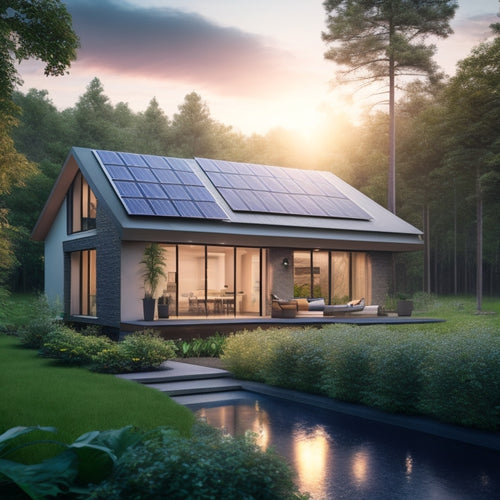
Geothermal Energy: Assessing Environmental Effects for Homeowners
Share
As you consider geothermal energy for your home, you're likely aware of its potential to reduce your carbon footprint and enhance energy independence. However, it's crucial to assess the environmental effects, such as land use and habitat disruption, water quality impacts, and air emissions and noise pollution. While geothermal energy has a smaller land-use footprint compared to fossil fuel-based plants, it can still affect local ecosystems and wildlife. Proper management, strategic placement, and community engagement can mitigate these effects. By understanding these factors, you can make an informed decision - and exploring these considerations further can help you maneuver the intricacies of geothermal energy.
Key Takeaways
- Geothermal energy has negligible greenhouse gas emissions, reducing carbon footprint and reliance on finite resources, making it an environmentally friendly option for homeowners.
- While geothermal facilities can disrupt local ecosystems, strategic placement and habitat restoration efforts can minimize environmental impacts and preserve natural habitats.
- Homeowners should be aware of potential water quality impacts, including groundwater contamination, and ensure regular water testing and monitoring to mitigate risks.
- Geothermal energy facilities can generate noise pollution, but scheduling construction during off-peak hours and implementing noise reduction measures can minimize disturbances.
- Responsible resource management and monitoring are crucial to ensure long-term sustainability and minimize the risk of resource scarcity for homeowners relying on geothermal energy.
Environmental Benefits of Geothermal
Nearly all geothermal power plants generate electricity with negligible greenhouse gas emissions, making them an attractive alternative to fossil fuels. As you consider switching to geothermal energy, you'll benefit from a renewable resource that's kind to the environment.
Geothermal power plants boast high thermal efficiency, converting up to 23% of the Earth's heat into electricity, compared to traditional fossil fuels' 33-40% efficiency. This means you'll produce less waste and pollution, contributing to a cleaner atmosphere.
By utilizing the Earth's natural heat, you'll reduce your reliance on finite resources and decrease your carbon footprint. In addition, achieving energy independence minimizes reliance on the grid and enhances brand reputation, much like solar-powered EV charging stations.
With geothermal energy, you're not only powering your home but also investing in a sustainable future.
Land Use and Habitat Disruption
As you investigate the benefits of geothermal energy, it's vital to acknowledge the potential drawbacks, particularly when it comes to land use and habitat disruption.
The geothermal footprint can be significant, requiring large areas for drilling and infrastructure installation. This can lead to habitat disruption, affecting local ecosystems and wildlife.
Additionally, strategic placement of wind turbines can maximize energy generation and achieve energy independence.
However, it's important to note that geothermal energy has a relatively small land-use footprint compared to traditional fossil fuel-based power plants.
Moreover, habitat restoration efforts can be implemented to mitigate the environmental impact.
Water Quality Impact Assessment
You've acknowledged the land use and habitat disruption associated with geothermal energy development. Now, it is vital to assess the water quality impact. As a homeowner, you should be aware of the potential risks to your water supply. Geothermal systems can contaminate groundwater if not properly designed and managed.
| Parameter | Potential Impact | Mitigation Measure |
|---|---|---|
| Temperature | Increase in water temperature | Implement temperature monitoring systems |
| pH | Changes in water pH | Conduct regular water testing |
| Chemical Composition | Introduction of contaminants | Implement contamination prevention measures |
| Turbidity | Increased sedimentation | Install sedimentation tanks |
| Bacterial Content | Increase in bacterial growth | Implement disinfection systems |
Regular water testing and contamination prevention measures can minimize the risks associated with geothermal energy development. It is vital to work with experienced developers who prioritize environmental sustainability and implement strong mitigation measures to protect your water supply.
Air Emissions and Noise Pollution
Geothermal energy development not only affects water quality but also has implications for air emissions and noise pollution.
As you consider geothermal energy for your home, it's crucial to understand the potential impact on air quality and noise levels in your community. In contrast to traditional power sources, geothermal energy can reduce carbon footprint, much like solar-powered EV charging, and emits some gases, including carbon dioxide, hydrogen sulfide, and methane, which can affect local air quality.
However, these emissions are generally lower than those from fossil fuel-based power plants. Noise pollution is another concern, as drilling and construction can generate significant noise.
Fortunately, noise reduction measures, such as sound barriers and scheduling construction during less populated hours, can minimize disturbances.
Resource Depletion and Scarcity
One of the primary concerns surrounding geothermal energy development is the potential for resource depletion and scarcity. You might wonder if geothermal energy is a sustainable option.
The good news is that geothermal energy is a renewable resource, meaning it's naturally replenished over time. However, the rate of replenishment can be slow, and excessive extraction can lead to supply sustainability issues.
To mitigate this, it's crucial to guarantee responsible resource management and monitoring, similar to how solar-powered systems require site assessments for peak installation.
Additionally, proper planning and budgeting, considering factors like installation costs and networked charging fees, can help maintain a stable and reliable geothermal energy supply, supporting long-term sustainability and reducing the risk of scarcity.
Visual and Aesthetic Impacts
As you consider the visual and aesthetic impacts of geothermal energy, you'll notice that land use alterations are a significant concern, since geothermal facilities often occupy large areas of land.
You'll also observe that equipment visibility can be an issue, particularly in areas of natural beauty or cultural significance.
Moreover, the integration of renewable energy sources can help mitigate these visual impacts by incorporating sustainable station designs that feature green roofs, rainwater harvesting, and solar panels.
In addition, you'll find that noise level impacts from drilling and operation can affect the ambiance of the surrounding environment.
Land Use Alterations
How drastically can the installation of geothermal facilities alter the natural scenery? As a homeowner, it's vital to evaluate the land use alterations that come with geothermal energy production. These alterations can have significant socioeconomic implications on your community.
-
Land acquisition and conversion of natural habitats can lead to habitat destruction and fragmentation.
-
Geothermal facilities can occupy large areas, potentially displacing existing land uses such as agriculture or conservation.
-
The installation process can cause soil erosion and alter soil quality, affecting local ecosystems.
- Community engagement is imperative to mitigate these effects and guarantee that geothermal energy development aligns with local values and goals.
Equipment Visibility Concerns
Industrial-scale geothermal facilities can dominate the terrain, raising concerns about equipment visibility and its impact on the natural scenery.
As a homeowner, you might worry about the visual impact of geothermal equipment on your property's aesthetic appeal. Equipment placement is critical in minimizing visual disturbance.
Strategically positioning equipment in areas with natural screening, such as trees or slopes, can reduce visibility. Additionally, using camouflage or paint that blends with the surroundings can help mitigate visual effects.
However, it's crucial to evaluate your personal preferences regarding equipment visibility. Some homeowners may prioritize energy efficiency over aesthetic concerns, while others may prefer more discreet equipment placement.
Understanding your priorities will help determine the best approach to equipment placement and visual impact mitigation.
Noise Level Impacts
Geothermal energy facilities can also generate noise, which may be a concern for nearby residents and homeowners. You may wonder how this could impact your daily life.
-
Noise levels can be reduced through proper sound insulation and equipment placement.
-
Regular maintenance can also minimize noise generation from the facility.
-
Open communication with facility operators can help address any noise concerns you may have.
- By promoting good neighborhood relations, you can work together to find solutions that benefit everyone involved.
Mitigating Geothermal Energy Risks
You'll need to implement strategies to mitigate the risks associated with geothermal energy production.
This involves incorporating land use planning into your project development to minimize the impact on ecosystems and wildlife habitats.
Land Use Planning
How can land use planning mitigate the risks associated with geothermal energy development?
By carefully selecting sites and implementing zoning regulations, you can minimize the environmental impacts of geothermal energy production. Effective land use planning guarantees that geothermal facilities are located in areas with minimal ecological sensitivity and low population density.
-
Identify areas with high geothermal potential and minimal environmental concerns
-
Establish zoning regulations that separate geothermal facilities from residential areas and sensitive ecosystems
-
Designate buffer zones to protect groundwater sources and wildlife habitats
- Develop contingency plans for unexpected environmental impacts
Safe Drilling Practices
During the exploration and production of geothermal energy, drilling operations pose considerable environmental and health risks if not conducted properly.
As you consider geothermal energy for your home, it's vital to understand the importance of safe drilling practices. Advanced drilling technology and adherence to strict safety regulations are imperative in minimizing risks. This includes ensuring wellbore integrity, managing drilling fluids, and monitoring for potential hazards.
By implementing these measures, you can greatly reduce the likelihood of environmental contamination, groundwater pollution, and health risks associated with geothermal energy production.
Frequently Asked Questions
Can Geothermal Energy Systems Be Used for Cooling as Well as Heating?
You can utilize geothermal energy for both heating and cooling, leveraging the Earth's consistent temperature for energy efficiency. In summer, you'll appreciate geothermal cooling, which can be up to 50% more efficient than traditional air conditioning systems.
Do Geothermal Systems Require Regular Maintenance and Upkeep?
You're the conductor of your home's energy orchestra, and regular maintenance is the harmony that keeps your geothermal system in tune, ensuring system efficiency and minimizing maintenance costs, so you can enjoy the sweet melody of freedom from high energy bills.
How Long Does It Take to Install a Geothermal Energy System?
You'll typically spend 2-5 days on installation, depending on system complexity and site conditions, with total installation costs ranging from $10,000 to $30,000, although these figures can vary considerably, affecting your overall installation timeline.
Can I Install a Geothermal System in an Existing Home?
You can install a geothermal system in an existing home, but it's essential to assess the geothermal installation feasibility, considering factors like property size and soil type, to guarantee a cost-benefit analysis that justifies the homeowner cost benefit.
Are Geothermal Energy Systems Eligible for Government Incentives?
As you traverse the financial terrain, a pot of gold awaits: geothermal energy systems are eligible for government incentives, offering you tax credits and financial rebates to offset installation costs, providing a guiding light of hope for your wallet.
Related Posts
-

3 Best Eco-Grants for Home Energy Upgrades
You're eligible for various eco-grants that can help you cut down on energy bills and reduce your carbon footprint by...
-

3 Earth-Loving Furniture Tips for Energy-Smart Homes
When furnishing your energy-smart home, you have the power to reduce your carbon footprint greatly by making consciou...
-

10 Powerful Electric Mowers for Expansive Lawns
You're moving away from gas-powered mowers and exploring electric options for your expansive lawn. You'll find that h...


